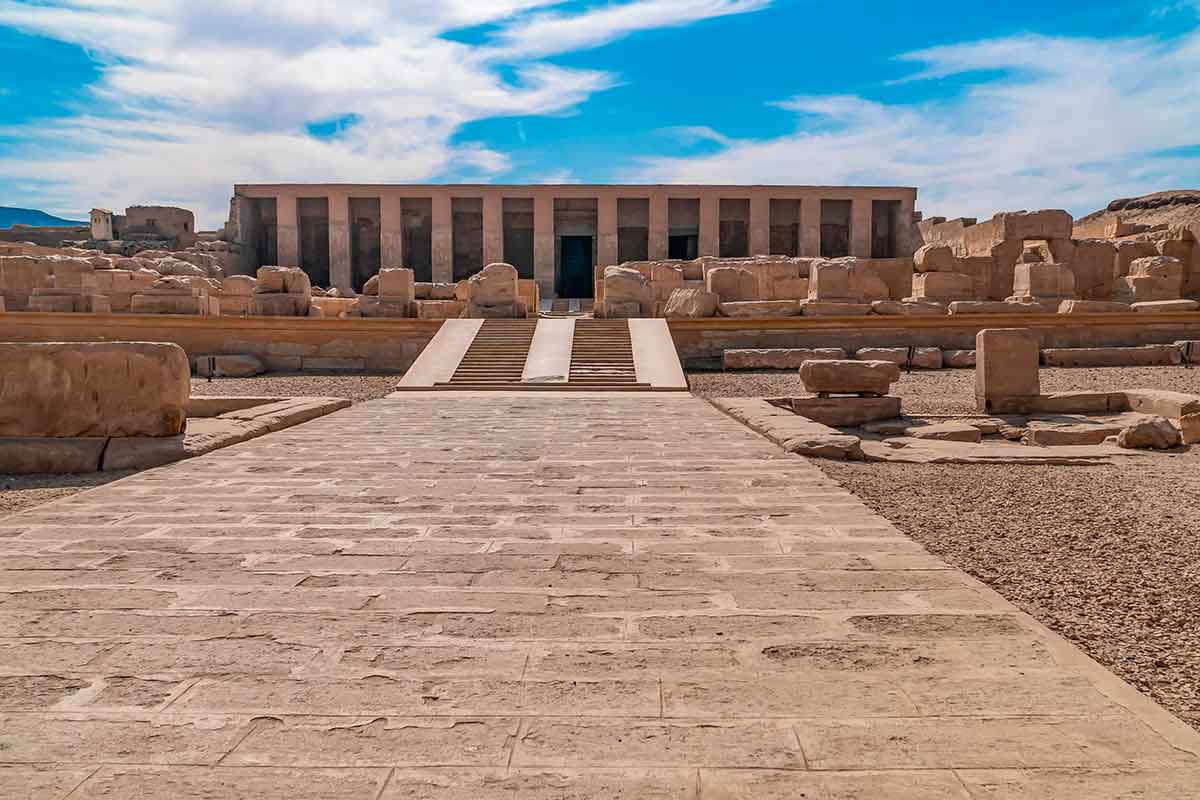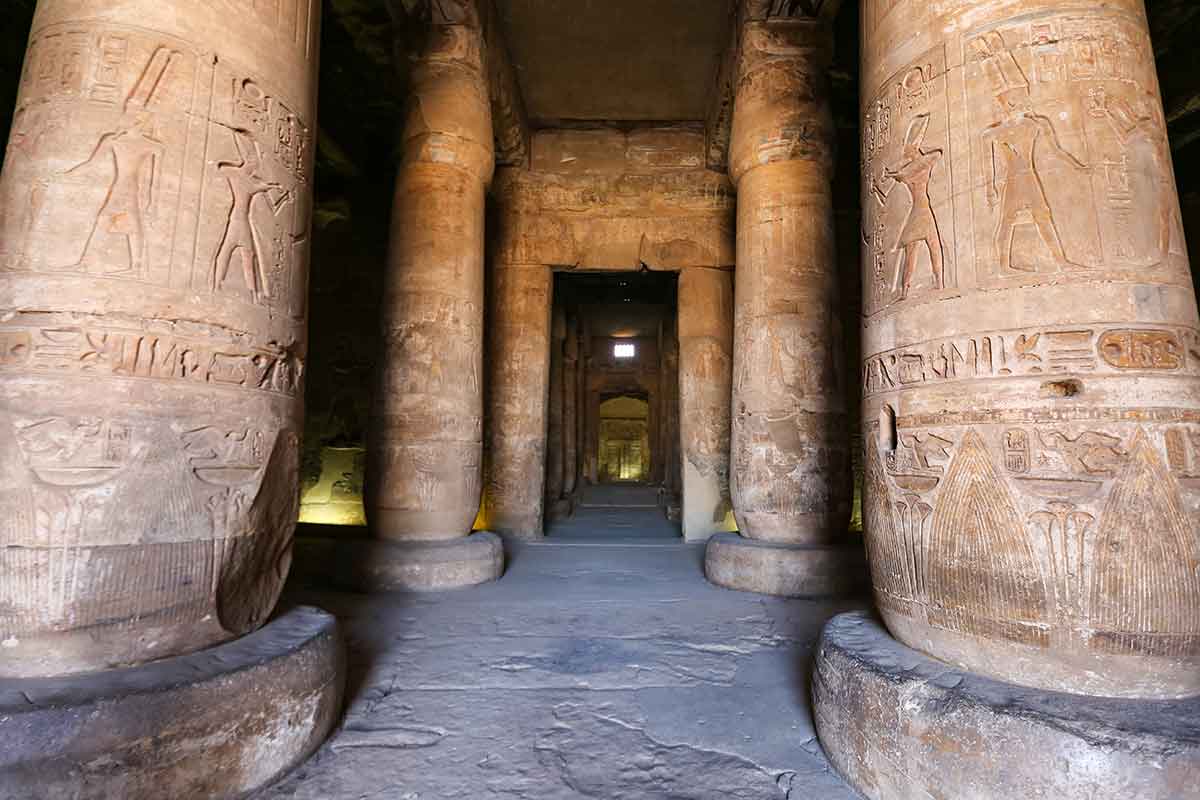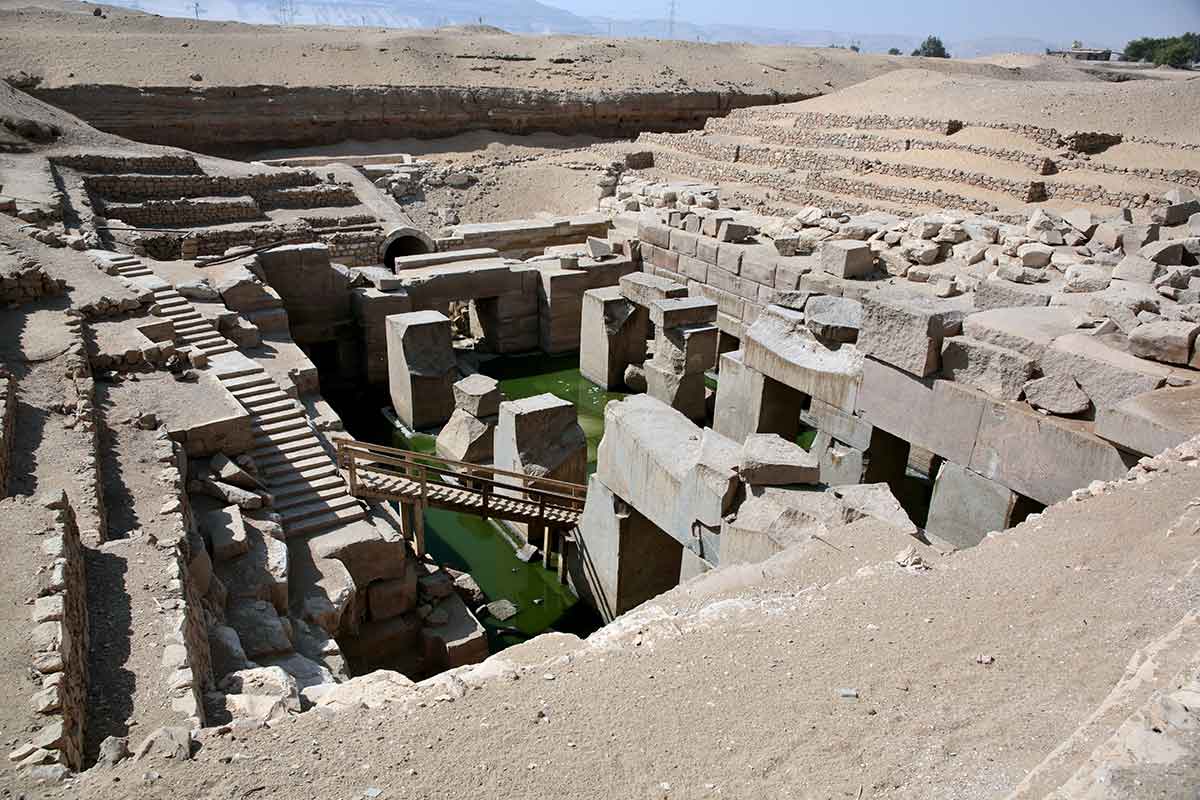The temple of Abydos in Middle Egypt holds a special place in the hearts of many visitors. Some even compare it to the Sacred Mosque of Mecca due to its significance as a center of worship for the god Osiris. It was once a popular destination for pilgrims who believed that Abydos was the gateway to the afterlife.
Visiting the temple of Abydos and the surrounding archaeological sites is an essential experience for anyone seeking to understand the civilization and beliefs of ancient Egypt. It’s also an opportunity to marvel at some of the finest artistic expressions of this ancient culture, which have survived for millennia.
Despite its global fame, the Abydos Temple isn’t usually overcrowded, thanks to its location in Middle Egypt. It’s situated in the village of El Araba El Madfuna, which falls under the administrative jurisdiction of Al-Balyana (or Al Belina) in the Governorate of Sohag. The closest city is Sohag, which is approximately 50 km north of Abydos. Luxor, located further south, is about 190 km away.
The temple is situated in a desert area near the western bank of the Nile River, where the fertile land ends. The village of El Araba El Madfuna depends heavily on the tourism generated by the Abydos Temple and other nearby sites, as well as the crops in the area, mainly sugarcane.

The significance of Abydos in ancient Egypt cannot be overstated, as its importance dates back to the origins of the civilization. In fact, it is believed that the city of Thinis, the first capital of unified Ancient Egypt, was located in the vicinity of Abydos. This led to the establishment of the first great royal necropolis in Umm el-Qaab nearby. It was, therefore, the place where important pharaohs of the first and second dynasties (ca. 3050-2700 BC), including Narmer and Khasekhemwy, among others, were born and buried.
Evidence of this early Egyptian culture can be found in the clay tablets and decorated jars discovered in the burial of King Scorpion I in the Umm el-Qaab necropolis. These artifacts, which date back to around 3300 BC, are considered to be one of the earliest examples of writing. As such, this place is often regarded as one of the cradles of civilization.
Although the Abydos temple and other religious constructions focused on this place as a religious center until recently, archaeological discoveries in 2016 demonstrated that it was a city from the beginning. The settlement has over 5,000 years of history, and remains of huts, iron tools, ceramic fragments, and human burials have been identified, shedding new light on the ancient history of the area.
Over the centuries, the Abydos temple was constantly expanded, with Pepi I (Dynasty VI, Old Kingdom) making significant contributions. The main local deity was Jentymentiu, but it later became assimilated to Osiris and became the main sacred place for the cult of this god, the judge of the dead in their aspiration to achieve eternal life. Mentuhotep III and Sesostris III (Dynasties XI and XII, Middle Kingdom) carried out significant works such as tombs, cult temples, royal chapels, and more.
The largest constructions came in the New Kingdom, when monarchs of Dynasty XVIII (Ahmose I, Thutmose III), in the 15th century BC, made the Abydos temple even larger, with an even more monumental processional way. However, the pharaoh Akhenaten established a virtually monotheistic cult, with the supremacy of the god of the solar disk, Aten, which disrupted the period of Amarna and relegated Osiris to a secondary role.
With the fall of Akhenaten and his legacy, the rebirth of this religious center came, and the name forever linked to the Abydos temple is that of Seti I of Dynasty XIX. This pharaoh, father of Ramses II, set out to continue the restoration of the Egyptian religion that had already begun with earlier monarchs, including Tutankhamun.
The Abydos temple, also known as the Temple of Seti I, was completed by his son Ramses II, and other later monarchs of the same dynasty made their contributions, such as Merenptah, who ordered the construction of the Osireion.
Ahmose II of Dynasty XXVI carried out certain reforms, and the last known pharaoh to have intervened was Nectanebo I of Dynasty XXX. With the Greco-Roman period, the importance and symbolism of the Abydos temple in Egypt declined.

Abydos boasts some of Ancient Egypt’s most stunning artistic treasures. At first glance, the grandeur and solemnity of the temple are easy to appreciate, but to truly understand its significance and beauty, it’s best to have some context. That’s where our expert guides come in, but for now, we’ll provide a brief overview of the must-see attractions in the area, including the Temple of Abydos (also known as the Temple of Seti I), the Osireion, and other nearby archaeological sites, such as the Shunet El Zebib and the Umm el-Qaab necropolis.
The Temple of Abydos is also referred to as the Great Temple of Abydos or the Funerary Temple of Seti I, who was a significant patron of the temple’s construction. However, as previously mentioned, many other pharaohs also contributed to the temple’s expansion and development. Although the temple is often called “funerary,” it should be noted that it was a cenotaph temple that complemented the Osireion. Seti I’s tomb and mummy were located in the Valley of the Kings in Thebes (Luxor).
The temple of Abydos served to honor all the great gods of the Egyptian religion and the pharaohs who preceded Seti I, while intentionally forgetting the monarchs considered usurpers or heretics, such as Hatshepsut and Akhenaten, as well as the denigrated god of the solar disk, Aton. Two essential elements of any visit to the temple make this clear:
Despite the disappearance of some elements, such as entrance pylons, the temple of Abydos still holds treasures of extraordinary beauty and delicacy, such as the bas-reliefs in the hypostyle hall.

The Osireion is a cenotaph commissioned by Seti I to be built next to the temple of Abydos. Despite its current deteriorated state, researchers have identified different spaces within the structure, including a vaulted corridor, an antechamber, and a large central chamber. Some parts of the Osireion feature decoration in the style of the Book of the Gates, a mural typology widespread among pharaohs in the New Kingdom, as can be seen in the tombs of the Valley of the Kings, for example.
Some experts speculate that this cenotaph was designed to evoke the primordial hill and primordial waters present in the theory of Egyptian creation. However, the Osireion is currently not visitable because it is partially flooded due to the rise of the water table of an underground aquifer.
While the temple of Abydos is undoubtedly the main attraction, there are other fascinating places to explore in the vicinity that may pique the interest of archaeology and ancient Egypt enthusiasts. One such place is the Umm el-Qaab necropolis, located around 500 meters west of the temple of Abydos. Although few identifiable royal burial remains exist in this area, its antiquity makes it a compelling site to visit.
Another noteworthy location is the Shunet El Zebib, situated approximately 500 meters north of the temple of Abydos. This structure is of immense archaeological significance, featuring two walls constructed of adobe bricks dating back to around 2700 BC, during the reign of Pharaoh Khasekhemwy in the 2nd Dynasty. Built over 4,700 years ago, it still stands today!
It is considered a precursor to stepped pyramids due to its similarities in construction. For a long time, it was believed to have a military function and was even referred to as the Middle Fort. However, modern experts now lean more towards regarding it as a funerary and religious structure, likely a Ka Chamber where the statue of the deceased was kept, housing their life force (ka).
Located in Middle Egypt, Abydos is easily accessible by several transportation options. On our dedicated page for this area, we provide more details on how to get here. If you prefer air travel, the closest airport is Sohag, while Luxor airport offers a wider range of flights. To reach Luxor, you can take a bus or an overnight train.
Regardless of your preferred mode of transportation, private road transport service is essential. Not only does it facilitate your travel from Sohag or Luxor to the vicinity of the temple of Abydos, but it also allows you to explore nearby attractions like Umm el-Qaab and Shunet El Zebib.
By hiring a private road transport service with a professional driver, you can even include other destinations on your itinerary, such as Dendera, which lies between Abydos and Luxor. These two sites are among the most fascinating ancient monuments in Middle Egypt and the entire country.
At Egipto Exclusivo, we offer a bespoke service with a professional driver and a well-equipped vehicle, ensuring your safety and comfort during your travels. We take care of all the essential details, including accommodation and meals.
If you’re planning a Nile cruise, we have interesting proposals for river trips that cover these sites. Contact us to start planning your experience exploring the temple of Abydos and other fascinating destinations in Egypt!


Fill out the form below to receive a free, no-obligation, tailor-made quote from an agency specialized in Egypt.
Travel agency and DMC specializing in private and tailor-made trips to Egypt.
Mandala Tours, S.L, NIF: B51037471
License: C.I.AN-187782-3